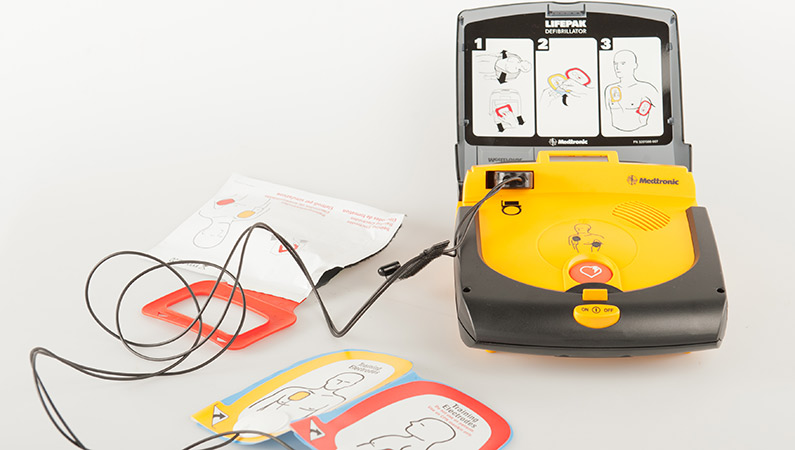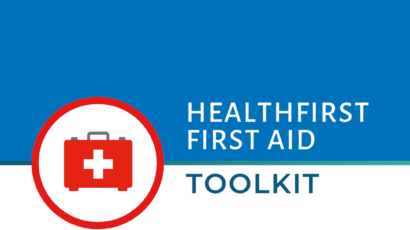by Senior HealthFirst trainer, Midwife/Nurse Polly Pupulin
What is an Automated External Defibrillator or AED?
An Automated External Defibrillator (AED or Defibrillator) delivers an electrical shock to a heart when used after a cardiac arrest. You can’t accidentally shock someone with one. These devices are designed to only deliver a shock when necessary. And yes, you can use an AED if you don’t speak the language!
AED’s communicate to us in multiple ways:
- They talk to us, guiding us through the stressful moments of providing care to a person in cardiac arrest
- There are visual pictures to guide us
- The AED gives an alarm at the critical moment when a shock needs to be delivered
During our Saving Lives courses at HealthFirst, people ask “what if we don’t speak the language of the AED?” However not speaking the language may not be the only barrier to understanding the audio guidance. The surroundings may be very noisy, or you might not be able to hear the audio prompts clearly.
There was a small study* carried out with nine deaf people who had not attended any previous training. Seven were immediately able to defibrillate a manikin following visual instructions. After training, all nine of the participants successfully and safely delivered a shock to the manikin. This demonstrates that not understanding the AED language does not need to be a barrier to using one.
What do I do if I think someone’s heart has stopped beating?
- Call 144 before you do anything. The 144-telephone operator is trained to talk you through the steps, and they may speak your language. Don’t be afraid to ask.
- Put your phone on speaker mode and follow their instructions.
Be confident when using an AED

- Remove the AED from the wall unit. You may need to pull open the outer box hard.
- Take it to the victim and open it up, checking pockets to find everything you might need. There are scissors to cut open clothing (including bras), a razor to shave a very hairy chest, and a wipe to dry the chest to ensure pads stick firmly.
- Place the pads on the bare skin of the victim’s chest as directed in the pictures on the AED.
- Listen to the voice prompts and follow any instructions . If you do not understand the spoken language, there might be a button to change language.
- Shout out and ask for help; can anyone translate the instructions to you?
- Once the pads are in place, the AED will tell you not to touch the victim as it checks the heart rhythm. Once the heart rhythm is established, it will tell you if a shock is advised or not. If a shock is advised, the AED will start alarming and flashing.
- If the AED is semi-automatic, you will be instructed to press the flashing button to deliver the shock. If it is completely automatic, the shock will be delivered for you and prompted by a countdown to give you time to move away from the victim. It is important that no one touches the victim during the delivery of a shock. When a shock is given, the person’s body will jerk like you see on TV.
- The AED will prompt you when it is safe to restart CPR (giving chest compressions +/- rescue breaths). Some play a sound to help you time how fast to give your 30 chest compressions and 2 rescue breaths.
- The AED will re-evaluate the victims heart rhythm every two minutes and continue to guide you with instructions.
- Once the AED pads are on the victim, do not remove them. Even if the person shows signs of life, leave the pads in place.
Do’s and Don’ts
Do:
- Continue giving CPR (chest compressions +/- rescue breaths) while waiting for an AED.
- Use an AED as soon as you can – the quicker it is used, the better the chance of survival.
- Place the sticky pads in position as shown on the diagram or the pads.
- Shave a very hairy chest.
- Dry the chest if it is wet.
- Use an AED on an aeroplane during a flight if needed.
- Use an AED on someone with a pacemaker, implanted defibrillator, or with a portocath fitted (provided they are in cardiac arrest).
Do Not:
- Use an AED in a swimming pool or lake – remove the person to the pool side or lake shore.
- Use an AED on a moving train or vibrating machinery. Pull the emergency stop first.
- Touch the victim when the AED is checking for a heart rhythm or delivering a shock.
- Place the pads on jewellery or over the top of an internally fitted pacemaker.
- Replace the pads if you have put them on the wrong way around – the AED will still work.
Where can I find an AED?
You can find AED’s in banks, sports centres, shopping centres, cinemas, tourist attractions, hotels, pharmacies, schools, town halls and the workplace. To track down where you might find one, check out the Staying Alive App. However, there is currently no obligation to register an AED on this App, so you may know one even closer. The App will also guide you how to use one.
To find out more and practice using an AED, we recommend you attend a training course. To check for our future courses, follow this link https://healthfirst.ch/first-aid-courses-switzerland/public-courses/
Remember
AEDs are very safe to use. Don’t be frightened of them – they could save someone’s life.
* https://www.resuscitationjournal.com/article/S0300-9572(04)00129-7/fulltext





